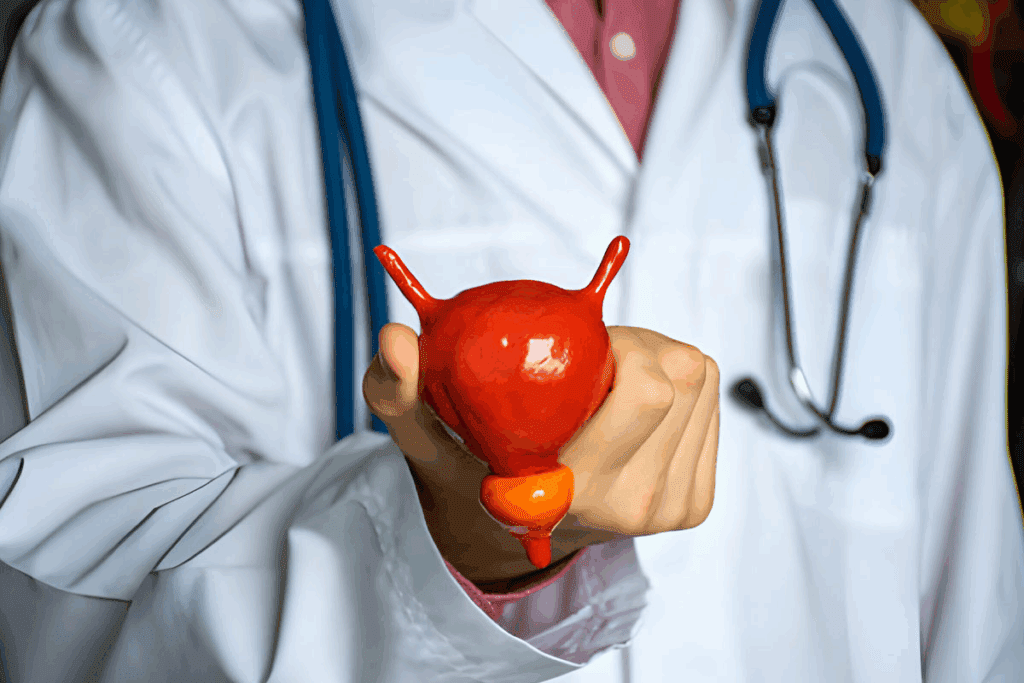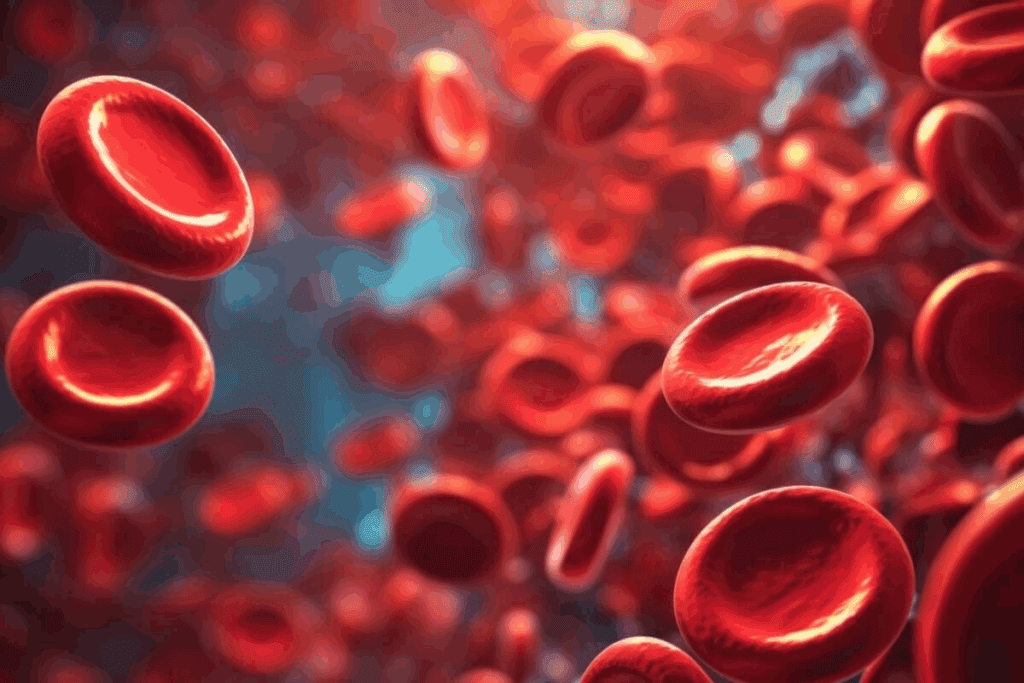
Discovering blood clots in the bladder can be scary, but it’s common and treatable. When blood loss causes clots and blocks urine flow, quick action is key.
At Liv Hospital, we focus on you in urology care. We use the latest tools and methods. Our team aims to treat you quickly and with care.
It’s important to know why blood clots happen, spot the signs, and learn about treatments like cystoscopy and clot evacuation. We’ll walk you through how to manage bladder blood clots effectively.

Blood clots in the bladder can cause a lot of pain and serious problems if not treated quickly. We will explore what bladder blood clots are, how they form, and the dangers they pose.
Bladder blood clots are like jelly-like masses that form when blood coagulates in the bladder. They can block urine flow, causing various symptoms. These clots usually form as a response to bleeding in the urinary system.
Blood clots in the urinary system form as a natural response to bleeding. When there’s an injury or infection, platelets and fibrin work together to stop the bleeding by forming a clot. In the bladder, this can happen due to trauma, infection, or other conditions.
Key factors that contribute to clot formation include:
If bladder blood clots are not treated, they can cause serious problems. These include urinary retention, where the clot blocks urine flow, and bladder tamponade, a condition where the clot fills the bladder, leading to severe consequences.
Some possible complications are:
It’s important for patients to understand the need for medical care if they have symptoms of bladder blood clots.

It’s important to know why bladder blood clots happen. This knowledge helps doctors treat them better. Blood clots in the bladder can come from many things. Finding out what causes them is key for treatment.
Procedures like TURP and laser prostatectomy can cause bladder blood clots. These surgeries help with prostate problems but can lead to bleeding. Post-surgical bleeding is a big concern that needs watching and managing.
Bladder tumors and cancer can cause blood in the urine. This blood can clot in the bladder. The presence of malignant cells can mess with the bladder’s normal function, leading to clotting.
UTIs and inflammation can also lead to bladder blood clots. Infections can irritate and bleed in the urinary tract, causing clots. Severe infections can make a lot of blood in the urine, raising clot risk.
Trauma to the bladder or pelvis can cause bleeding and clots. Other health issues, like bleeding disorders or anticoagulant use, can also raise clot risk. It’s vital to manage these conditions well to avoid clot problems.
It’s important to know the signs of bladder clots to avoid serious problems. Blood clots in the bladder can cause different symptoms. These symptoms can range from mild to severe.
Hematuria, or blood in the urine, is a common sign. The urine might look pink, red, or cola-colored. If you see blood in your urine, it’s important to see a doctor, even more so after surgery.
“Seeing blood in your urine means something is wrong with your urinary system,” says a top urologist. “You should get medical help right away to check for serious issues.”
Bladder clots can block urine flow, causing urinary retention. This can lead to pain, discomfort, and feeling like you can’t fully empty your bladder. In bad cases, you might not be able to pee at all, which is a serious problem.
Pain often comes with bladder clots. The pain might be in your lower abdomen, pelvis, or back. It can feel like a dull ache or sharp pains. The pain might be constant or only happen when you pee.
In severe cases, bladder clots can cause bladder tamponade. This is when clots fill the bladder and block urine flow. Signs include severe pain, not being able to pee, and serious health risks if not treated fast. Bladder tamponade is a medical emergency that needs quick action.
Knowing these symptoms can help you get medical help quickly. If you’re showing any of these signs, call your doctor right away.
Diagnosing bladder clots is key to treating them well. We use a mix of physical checks, lab tests, and imaging to find and measure blood clots in the bladder.
The first step is a physical check. We look for signs like trouble peeing, pain, or discomfort. This helps decide what tests to do next.
Urinalysis is vital for spotting blood in urine, a sign of bladder clots. We check urine for blood, infection, or other issues. Blood tests also check overall health and look for underlying causes.
Laboratory tests help us:
Imaging like ultrasound or CT scans gives us detailed views of the bladder and urinary tract. These tests show us the clots, their size, and any other issues.
Imaging studies are useful for:
Diagnostic cystoscopy lets us see inside the bladder. It helps us find and measure blood clots and figure out why they’re bleeding. We can also take tissue samples for more tests if needed.
By using these methods together, we can accurately find and treat bladder blood clots. We make a treatment plan that fits the patient’s needs.
Handling bladder clots quickly is key to avoid serious problems. If there’s a lot of blood and clots, you need to see a doctor right away. This is to stop issues like not being able to pee and bladder tamponade.
Knowing when to get medical help for bladder clots is important. Look out for blood in your pee, trouble peeing, and a lot of pain. If you see these signs, go to the emergency room without delay.
Key indicators for immediate medical care:
First steps in treating bladder clots include using a catheter and irrigation. This clears the clots and helps you pee normally again. It also makes you feel better.
Catheterization and irrigation are critical steps in managing bladder clots. These are done quickly in an emergency setting to fix the problem fast.
Medicines are very important in stopping bleeding from bladder clots. Drugs like tranexamic acid help keep the clots stable and reduce bleeding. The right medicine and how much depends on your health and past medical history.
We use these medicines carefully to stop bleeding. We watch for any side effects. Our goal is to keep you stable and stop more bleeding.
Stopping bladder tamponade is a big part of managing bladder clots. This happens when a big clot blocks the bladder outlet, causing trouble peeing. We use continuous bladder irrigation and watch you closely to prevent this.
Preventive measures include:
Understanding cystoscopy and clot evacuation is key for managing bladder clots. A telescope is inserted through the urethra to see the bladder. Clots are then removed using suction or special tools.
Before cystoscopy and clot evacuation, patients go through a detailed preparation. They review their medical history, current medications, and allergies. We also make sure they understand the procedure and give informed consent.
The procedure is done under anesthesia to reduce discomfort. The type of anesthesia depends on the patient’s health and the urologist’s choice.
During cystoscopy, a cystoscope is used to see the bladder and find clots. The cystoscope has a camera and light, making it easy to see inside the bladder.
Clots are removed by suction or special tools like tissue morcellators. These tools break down clots into small pieces that can be suctioned out.
Special tools are key in cystoscopy and clot evacuation. Tissue morcellators, for example, break down clots into smaller pieces for removal.
Using these tools requires skill to avoid harming the bladder or causing bleeding.
After the procedure, patients are watched for any immediate issues. We give them instructions on how to care for themselves, including managing any discomfort or bleeding.
Recovery times vary, but most can get back to normal in a few days. Follow-up appointments are set to check on healing and address any concerns.
| Procedure Aspect | Description | Recovery Time |
| Cystoscopy | Visualization of the bladder using a cystoscope | 1-2 days |
| Clot Evacuation | Removal of clots using suction or specialized instruments | 2-3 days |
| Post-Procedure Care | Monitoring and management of post-procedure symptoms | Ongoing |
As a urology expert said, “Cystoscopy and clot evacuation are key for managing bladder clots. The success depends on the precision of the procedure and the quality of care after it.”
“The use of cystoscopy and clot evacuation has revolutionized treating bladder clots. It offers patients a minimally invasive solution with great benefits.”
Medical Expert, Urologist
Catheter-based treatments are key for patients with bladder blood clots. They work well for big clots that block urine flow or cause a lot of bleeding.
Manual irrigation uses a catheter to clear blood clots from the bladder. It uses a big syringe to flush with saline solution. The aim is to remove clots that block the bladder.
The hydrogen peroxide solution method uses a diluted solution in the bladder. This method helps dissolve blood clots, making them easier to remove.
A three-way catheter is used for constant bladder irrigation. It lets in solution and out clots and debris. This method is great for ongoing bleeding.
Important things about three-way catheter management include:
Research shows catheter-based treatments work well for bladder blood clots. Success rates depend on the cause and severity of the clots.
| Treatment Method | Success Rate | Complication Rate |
| Manual Irrigation | 80% | 5% |
| Hydrogen Peroxide Solution | 75% | 8% |
| Three-Way Catheter | 90% | 3% |
Catheter-based treatments are a valuable option for bladder blood clots. The right method depends on the patient’s needs and situation.
After treating bladder blood clots, several key steps are important for recovery. Managing the post-treatment period well helps avoid complications and aids in healing.
Continuous bladder irrigation is a key part of care after treating bladder blood clots. It involves flushing the bladder with saline to stop new clots and help healing. This method reduces the risk of clot retention and bladder tamponade, which are serious issues.
Medicine is vital for managing symptoms and preventing issues after treating bladder blood clots. We might give:
Following the medication plan is key for a good recovery.
Patients should avoid hard work and heavy lifting to prevent clot dislodgment. Drinking enough water is also important to clean the bladder and prevent infection. It’s recommended to drink lots of water, unless a doctor says not to.
Having a follow-up care plan is important to track the patient’s recovery and catch any problems early. Follow-up visits may include:
Attending follow-up appointments is vital for a good outcome.
It’s important to treat the cause of blood clots in the bladder to stop them from coming back. Blood clots can happen for many reasons, like bladder tumors, UTIs, or after surgery. Fixing these problems is key to avoiding more clots and helping patients get better.
Bladder tumors are a big reason for blood clots. Managing bladder tumors means using surgery, medicine, and watching closely. A common surgery is called TURBT to remove tumors. Sometimes, medicine is used to lower the chance of tumors coming back.
For bigger tumors, a bigger surgery might be needed. Watching closely with tests and check-ups is important to catch any new tumors early. We help patients make a plan for follow-up visits that fits their needs.
UTIs are another reason for blood clots in the bladder. Quick treatment of UTIs is key to avoid problems like blood clots. Doctors usually use antibiotics to treat UTIs, based on how bad the infection is and the patient’s health history.
Along with antibiotics, supportive care like drinking lots of water and managing pain is important. We also teach patients how to prevent UTIs in the future, like keeping the genital area clean and practicing good urinary tract health.
After surgery, like TURP or laser prostatectomy, blood clots can form. Watching closely after surgery helps catch and manage any problems early.
We stress the importance of follow-up care after surgery. We watch for signs of bleeding or clots and take action if needed. Clear instructions are given to patients on how to care for themselves after surgery, including what activities to avoid and when to seek help.
Long-term plans are important to keep blood clots from coming back. This includes managing ongoing conditions like bladder tumors or UTIs, and making lifestyle changes to keep the urinary tract healthy.
We encourage patients to drink plenty of water, practice good hygiene, and go to regular check-ups. By working with our healthcare team, patients can lower their risk of getting blood clots again and keep their bladder healthy.
Treating blood clots in the bladder needs a full plan. This plan covers the causes, symptoms, and treatment choices. We’ve looked at how to handle bladder clots, from why they form to how to treat them.
Quick and right treatment is key to avoid serious problems. Spotting symptoms early and getting medical help can greatly lower the risk of lasting harm. We’ve talked about treatments like cystoscopy and catheter-based methods, and what to do after treatment.
In short, treating bladder blood clots is complex. It requires looking at each person’s situation and medical history. We stress the need for a custom plan to help patients get the best results.
Blood clots in the bladder are like gel-like masses of blood. They form in the bladder due to bleeding from surgery, tumors, infections, or trauma. The body tries to stop bleeding in the urinary tract by forming these clots.
Yes, they can be dangerous. Blood clots in the bladder can block urine flow and cause urinary retention. If not treated, they can lead to serious complications like bladder tamponade. We advise seeking immediate medical attention if symptoms persist.
Symptoms include visible blood in urine (hematuria) and difficulty urinating. You may also feel pain or discomfort in the lower abdomen. In severe cases, you might experience bladder tamponade symptoms like severe pain and inability to urinate. We recommend prompt evaluation if you experience these symptoms.
Diagnosis involves a physical examination and laboratory tests like urinalysis. Imaging studies and diagnostic cystoscopy are also used. These methods help confirm the presence and extent of clot formation.
Treatment options include cystoscopy and clot evacuation. We also use catheter-based treatments like manual irrigation and hydrogen peroxide solution. Managing underlying causes is key to preventing recurrence. We tailor the treatment to the individual’s condition and medical history.
Cystoscopy and clot evacuation involve visually examining the bladder with a cystoscope. We remove blood clots using specialized instruments. This procedure helps restore normal urine flow and addresses the underlying cause of bleeding.
Preventing recurrence involves managing underlying conditions like bladder tumors or urinary tract infections. Post-surgical monitoring and long-term prevention strategies are also important. We work with patients to develop a personalized plan to minimize the risk of future clot formation.
Continuous bladder irrigation helps flush out the bladder and prevent further clot formation after treatment. We often use this technique to ensure the bladder remains clear and promote healing.
Yes, they can be a sign of serious conditions like bladder cancer or severe infection. We thoroughly investigate the cause of clot formation to address any underlying issues.
Recovery time varies depending on the treatment method and individual factors. We provide a follow-up care schedule to monitor recovery, address any complications, and ensure the bladder returns to normal function.
National Center for Biotechnology Information. (2025). How to Treat Blood Clots in Bladder Complete. Retrieved from https://www.ncbi.nlm.nih.gov/pmc/articles/PMC7243400
Subscribe to our e-newsletter to stay informed about the latest innovations in the world of health and exclusive offers!
WhatsApp us